2011 PEUGEOT 5008 ESP
[x] Cancel search: ESPPage 132 of 340
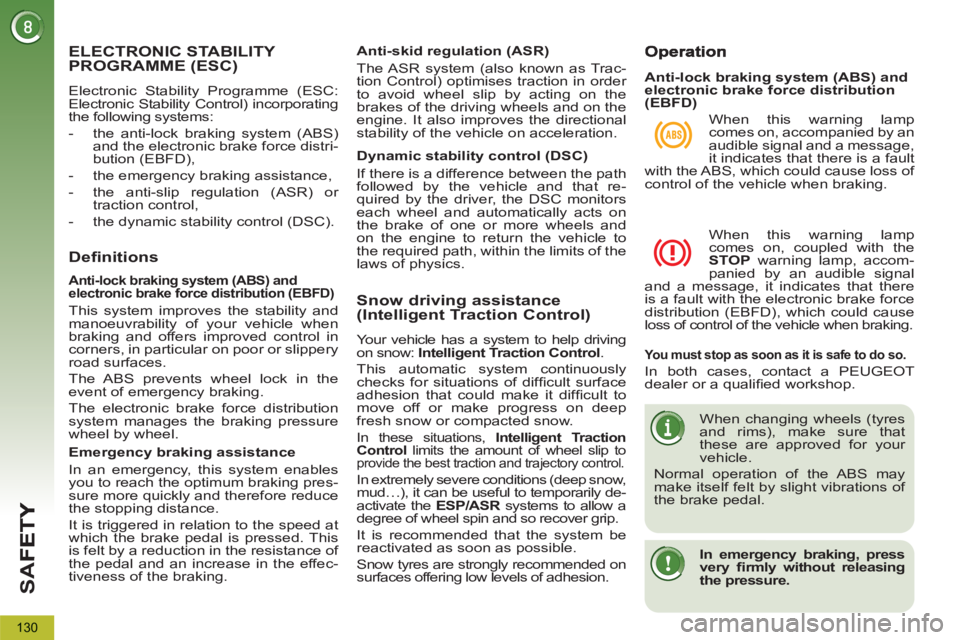
SA
F
130
ELECTRONIC STABILITY PROGRAMME (ESC)
Electronic Stability Programme (ESC:
Electronic Stability Control) incorporating
the following systems:
- the anti-lock braking system (ABS)
and the electronic brake force distri-
bution (EBFD),
- the emergency braking assistance,
- the anti-slip regulation (ASR) or
traction control,
- the dynamic stability control (DSC).
Definitions
Anti-skid regulation (ASR)
The ASR system (also known as Trac-
tion Control) optimises traction in order
to avoid wheel slip by acting on the
brakes of the driving wheels and on the
engine. It also improves the directional
stability of the vehicle on acceleration.
Dynamic stability control (DSC)
If there is a difference between the path
followed by the vehicle and that re-
quired by the driver, the DSC monitors
each wheel and automatically acts on
the brake of one or more wheels and
on the engine to return the vehicle to
the required path, within the limits of the
laws of physics.
Emergency braking assistance
In an emergency, this system enables
you to reach the optimum braking pres-
sure more quickly and therefore reduce
the stopping distance.
It is triggered in relation to the speed at
which the brake pedal is pressed. This
is felt by a reduction in the resistance of
the pedal and an increase in the effec-
tiveness of the braking.
Anti-lock braking system (ABS) and
electronic brake force distribution (EBFD)
This system improves the stability and
manoeuvrability of your vehicle when
braking and offers improved control in
corners, in particular on poor or slippery
road surfaces.
The ABS prevents wheel lock in the
event of emergency braking.
The electronic brake force distribution
system manages the braking pressure
wheel by wheel.
When this warning lamp
comes on, accompanied by an
audible signal and a message,
it indicates that there is a fault
with the ABS, which could cause loss of
control of the vehicle when braking.
When this warning lamp
comes on, coupled with the
STOP
warning lamp, accom-
panied by an audible signal
and a message, it indicates that there
is a fault with the electronic brake force
distribution (EBFD), which could cause
loss of control of the vehicle when braking.
You must stop as soon as it is safe to do so.
In both cases, contact a PEUGEOT
dealer or a qualifi ed workshop.
When changing wheels (tyres
and rims), make sure that
these are approved for your
vehicle.
Normal operation of the ABS may
make itself felt by slight vibrations of
the brake pedal.
In emergency braking, press
very fi rmly without releasing
the pressure.
Anti-lock braking system (ABS) and
electronic brake force distribution
(EBFD)
Snow driving assistance(Intelligent Traction Control)
Your vehicle has a system to help driving
on snow: Intelligent Traction Control.
This automatic system continuously
checks for situations of diffi cult surface
adhesion that could make it diffi cult to
move off or make progress on deep
fresh snow or compacted snow.
In these situations, Intelligent Traction
Control
limits the amount of wheel slip to
provide the best traction and trajectory control.
In extremely severe conditions (deep snow,
mud…), it can be useful to temporarily de-
activate the ESP/ASR
systems to allow a
degree of wheel spin and so recover grip.
It is recommended that the system be
reactivated as soon as possible.
Snow tyres are strongly recommended on
surfaces offering low levels of adhesion.
Page 133 of 340

SA
F
131
Dynamic stability control (DSC)
The DSC system offers excep-
tional safety in normal driving,
but this should not encourage the
driver to take extra risks or drive at high
speed.
The correct functioning of the system
depends on observation of the manu-
facturer's recommendations regarding
the wheels (tyres and rims), the braking
components, the electronic components
and the PEUGEOT assembly and op-
eration procedures.
After an impact, have the system
checked by a PEUGEOT dealer or a
qualifi ed workshop.
Deactivation
In exceptional conditions (starting a vehicle
which is bogged down, stuck in snow, on
soft ground...), it may be advisable to deac-
tivate the DSC system, so that the wheels
can move freely and regain grip.
�)
Press the "ESP OFF"
button.
This warning lamp and the indi-
cator lamp in the button come
on: the DSC system no longer
acts on the operation of the inter-
nal combustion engine.
Reactivation
The system is reactivated automatically
each time the ignition is switched back
on or from 30 mph (50 km/h).
Operating fault
If this warning lamp comes on,
accompanied by an audible sig-
nal and a message in the multi-
function screen, this indicates a
malfunction of the system.
Contact a PEUGEOT dealer or a quali-
fi ed workshop to have the system
checked.
This is indicated by fl ashing of this
warning lamp in the instrument
panel.
Activation
This system is activated automatically
each time the vehicle is started.
It comes into operation in the event of a
grip or trajectory problem.
�)
Press the "ESP OFF"
button again
to reactivate it manually.
Page 135 of 340
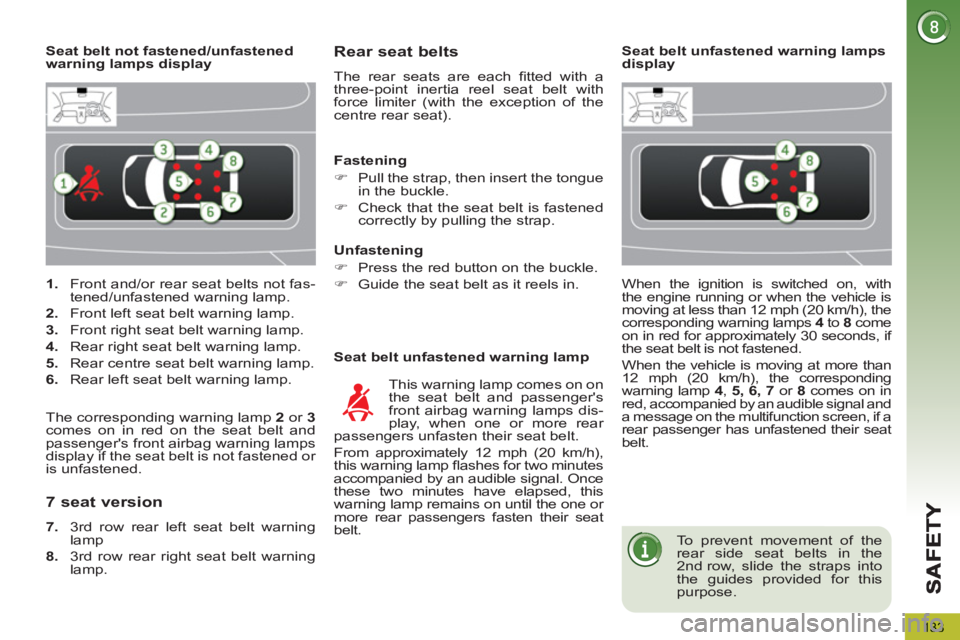
133
1.
Front and/or rear seat belts not fas-
tened/unfastened warning lamp.
2.
Front left seat belt warning lamp.
3.
Front right seat belt warning lamp.
4.
Rear right seat belt warning lamp.
5.
Rear centre seat belt warning lamp.
6.
Rear left seat belt warning lamp.
Seat belt not fastened/unfastened
warning lamps display
Rear seat belts
The rear seats are each fi tted with a
three-point inertia reel seat belt with
force limiter (with the exception of the
centre rear seat).
Seat belt unfastened warning lamp
This warning lamp comes on on
the seat belt and passenger's
front airbag warning lamps dis-
play, when one or more rear
passengers unfasten their seat belt.
From approximately 12 mph (20 km/h),
this warning lamp fl ashes for two minutes
accompanied by an audible signal. Once
these two minutes have elapsed, this
warning lamp remains on until the one or
more rear passengers fasten their seat
belt.
Fastening
�)
Pull the strap, then insert the tongue
in the buckle.
�)
Check that the seat belt is fastened
correctly by pulling the strap.
Unfastening
�)
Press the red button on the buckle.
�)
Guide the seat belt as it reels in.
The corresponding warning lamp 2
or 3
comes on in red on the seat belt and
passenger's front airbag warning lamps
display if the seat belt is not fastened or
is unfastened.
7 seat version
7.
3 rd
row rear left seat belt warning
lamp
8.
3
rd
row rear right seat belt warning
lamp.
Seat belt unfastened warning lamps
display
When the ignition is switched on, with
the engine running or when the vehicle is
moving at less than 12 mph (20 km/h), the
corresponding warning lamps 4
to 8
come
on in red for approximately 30 seconds, if
the seat belt is not fastened.
When the vehicle is moving at more than
12 mph (20 km/h), the corresponding
warning lamp 4
, 5, 6, 7
or 8
comes on in
red, accompanied by an audible signal and
a message on the multifunction screen, if a
rear passenger has unfastened their seat
belt.
To prevent movement of the
rear side seat belts in the
2 nd row, slide the straps into
the guides provided for this
purpose.
Page 136 of 340
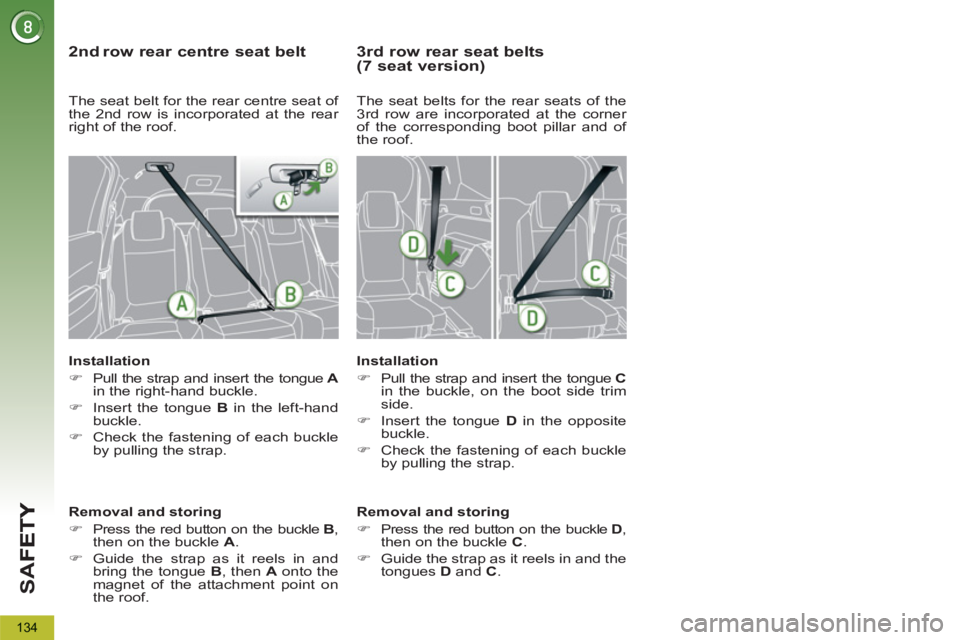
SA
F
134
2 ndrow rear centre seat belt
Installation
�)
Pull the strap and insert the tongue A
in the right-hand buckle.
�)
Insert the tongue B
in the left-hand
buckle.
�)
Check the fastening of each buckle
by pulling the strap.
Removal and storing
�)
Press the red button on the buckle B
,
then on the buckle A
.
�)
Guide the strap as it reels in and
bring the tongue B
, then A
onto the
magnet of the attachment point on
the roof.
3rd row rear seat belts (7 seat version)
Installation
�)
Pull the strap and insert the tongue C
in the buckle, on the boot side trim
side.
�)
Insert the tongue D
in the opposite
buckle.
�)
Check the fastening of each buckle
by pulling the strap.
The seat belts for the rear seats of the
3 r
d
row are incorporated at the corner
of the corresponding boot pillar and of
the roof.
Removal and storing
�)
Press the red button on the buckle D
,
then on the buckle C
.
�)
Guide the strap as it reels in and the
tongues D
and C
.
The seat belt for the rear centre seat of
the 2 nd row is incorporated at the rear
right of the roof.
Page 140 of 340
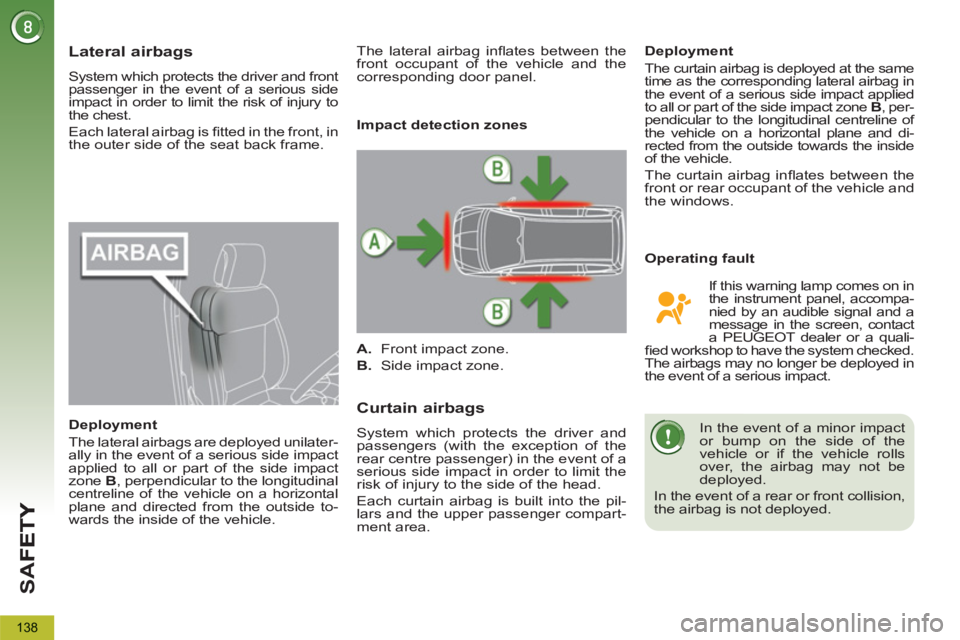
SA
F
138
Lateral airbags
System which protects the driver and front
passenger in the event of a serious side
impact in order to limit the risk of injury to
the chest.
Each lateral airbag is fi tted in the front, in
the outer side of the seat back frame.
Deployment
The lateral airbags are deployed unilater-
ally in the event of a serious side impact
applied to all or part of the side impact
zone B
, perpendicular to the longitudinal
centreline of the vehicle on a horizontal
plane and directed from the outside to-
wards the inside of the vehicle.
Curtain airbags
System which protects the driver and
passengers (with the exception of the
rear centre passenger) in the event of a
serious side impact in order to limit the
risk of injury to the side of the head.
Each curtain airbag is built into the pil-
lars and the upper passenger compart-
ment area.
Operating fault
Deployment
The curtain airbag is deployed at the same
time as the corresponding lateral airbag in
the event of a serious side impact applied
to all or part of the side impact zone B
, per-
pendicular to the longitudinal centreline of
the vehicle on a horizontal plane and di-
rected from the outside towards the inside
of the vehicle.
The curtain airbag infl ates between the
front or rear occupant of the vehicle and
the windows.
In the event of a minor impact
or bump on the side of the
vehicle or if the vehicle rolls
over, the airbag may not be
deployed.
In the event of a rear or front collision,
the airbag is not deployed.
Impact detection zones
A.
Front impact zone.
B.
Side impact zone.
If this warning lamp comes on in
the instrument panel, accompa-
nied by an audible signal and a
message in the screen, contact
a PEUGEOT dealer or a quali-
fi ed workshop to have the system checked.
The airbags may no longer be deployed in
the event of a serious impact. The lateral airbag infl ates between the
front occupant of the vehicle and the
corresponding door panel.
Page 145 of 340
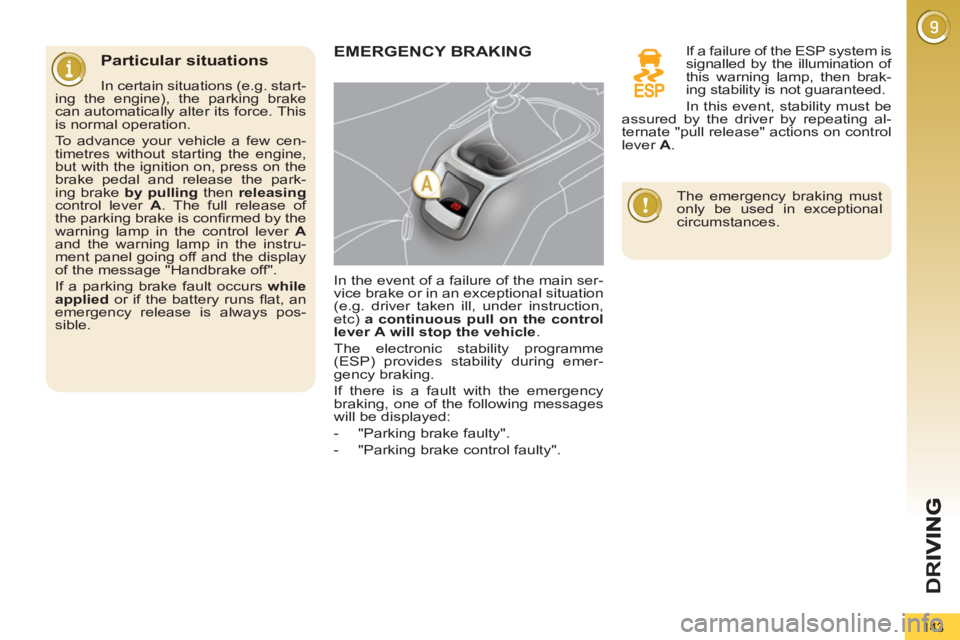
D
R
143
Particular situations
In certain situations (e.g. start-
ing the engine), the parking brake
can automatically alter its force. This
is normal operation.
To advance your vehicle a few cen-
timetres without starting the engine,
but with the ignition on, press on the
brake pedal and release the park-
ing brake by pulling
then releasing
control lever A
. The full release of
the parking brake is confi rmed by the
warning lamp in the control lever A
and the warning lamp in the instru-
ment panel going off and the display
of the message "Handbrake off".
If a parking brake fault occurs while
applied
or if the battery runs fl at, an
emergency release is always pos-
sible.
EMERGENCY BRAKING
In the event of a failure of the main ser-
vice brake or in an exceptional situation
(e.g. driver taken ill, under instruction,
etc) a continuous pull
on the control
lever
A
will stop the vehicle
.
The electronic stability programme
(ESP) provides stability during emer-
gency braking.
If there is a fault with the emergency
braking, one of the following messages
will be displayed:
- "Parking brake faulty".
- "Parking brake control faulty".
If a failure of the ESP system is
signalled by the illumination of
this warning lamp, then brak-
ing stability is not guaranteed.
In this event, stability must be
assured by the driver by repeating al-
ternate "pull release" actions on control
lever A
.
The emergency braking must
only be used in exceptional
circumstances.
Page 152 of 340
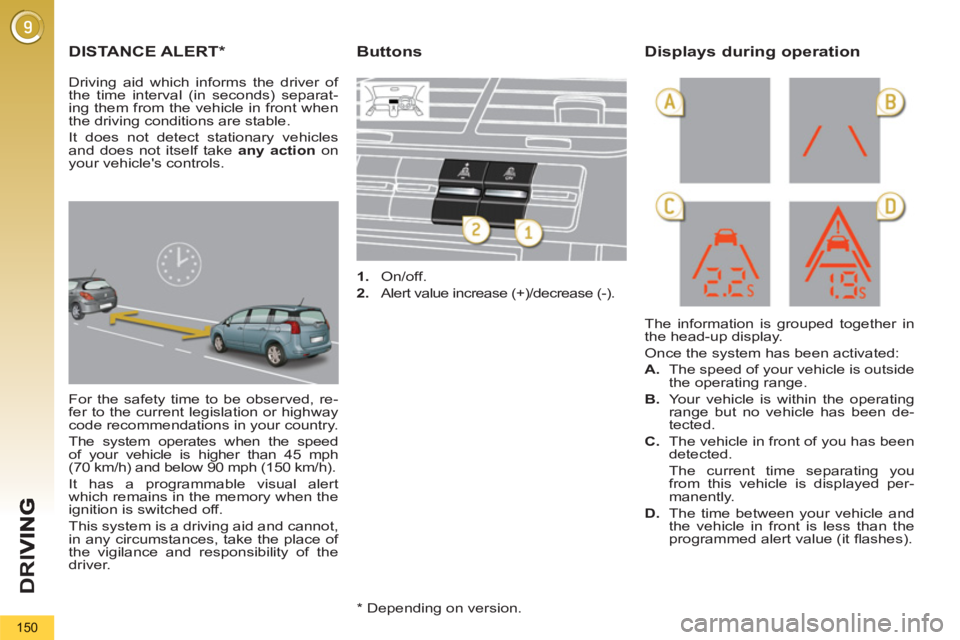
D
R
I
150
DISTANCE ALERT *
For the safety time to be observed, re-
fer to the current legislation or highway
code recommendations in your country.
The system operates when the speed
of your vehicle is higher than 45 mph
(70 km/h) and below 90 mph (150 km/h).
It has a programmable visual alert
which remains in the memory when the
ignition is switched off.
This system is a driving aid and cannot,
in any circumstances, take the place of
the vigilance and responsibility of the
driver.
1.
On/off.
2.
Alert value increase (+)/decrease (-).
The information is grouped together in
the head-up display.
Once the system has been activated:
A.
The speed of your vehicle is outside
the operating range.
B.
Your vehicle is within the operating
range but no vehicle has been de-
tected.
C.
The vehicle in front of you has been
detected.
The current time separating you
from this vehicle is displayed per-
manently.
D.
The time between your vehicle and
the vehicle in front is less than the
programmed alert value (it fl ashes).
Buttons Displays during operation
Driving aid which informs the driver of
the time interval (in seconds) separat-
ing them from the vehicle in front when
the driving conditions are stable.
It does not detect stationary vehicles
and does not itself take any action
on
your vehicle's controls.
* Depending on version.
Page 153 of 340
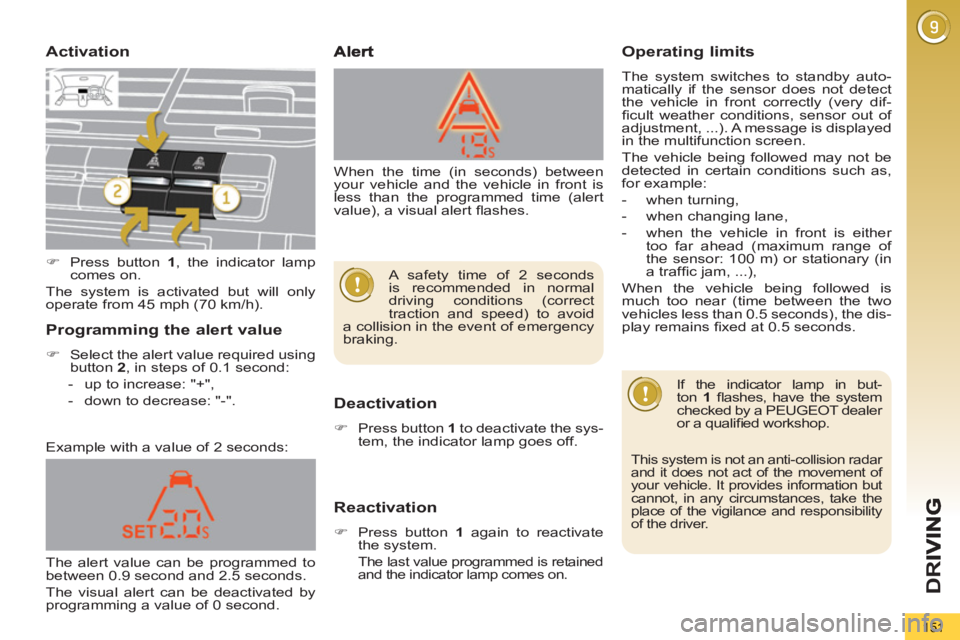
D
R
151
Activation
Deactivation
�)
Press button 1
to deactivate the sys-
tem, the indicator lamp goes off.
Reactivation
�)
Press button 1
again to reactivate
the system.
The last value programmed is retained
and the indicator lamp comes on.
If the indicator lamp in but-
ton 1
fl ashes, have the system
checked by a PEUGEOT dealer
or a qualifi ed workshop.
Example with a value of 2 seconds:
Operating limits
The system switches to standby auto-
matically if the sensor does not detect
the vehicle in front correctly (very dif-
fi cult weather conditions, sensor out of
adjustment, ...). A message is displayed
in the multifunction screen.
The vehicle being followed may not be
detected in certain conditions such as,
for example:
- when turning,
- when changing lane,
- when the vehicle in front is either
too far ahead (maximum range of
the sensor: 100 m) or stationary (in
a traffi c jam, ...),
When the vehicle being followed is
much too near (time between the two
vehicles less than 0.5 seconds), the dis-
play remains fi xed at 0.5 seconds.
Programming the alert value
�)
Select the alert value required using
button 2
, in steps of 0.1 second:
- up to increase: "+",
- down to decrease: "-".
This system is not an anti-collision radar
and it does not act of the movement of
your vehicle. It provides information but
cannot, in any circumstances, take the
place of the vigilance and responsibility
of the driver.
�)
Press button 1
, the indicator lamp
comes on.
The system is activated but will only
operate from 45 mph (70 km/h).
The alert value can be programmed to
between 0.9 second and 2.5 seconds.
The visual alert can be deactivated by
programming a value of 0 second. When the time (in seconds) between
your vehicle and the vehicle in front is
less than the programmed time (alert
value), a visual alert fl ashes.
A safety time of 2 seconds
is recommended in normal
driving conditions (correct
traction and speed) to avoid
a collision in the event of emergency
braking.